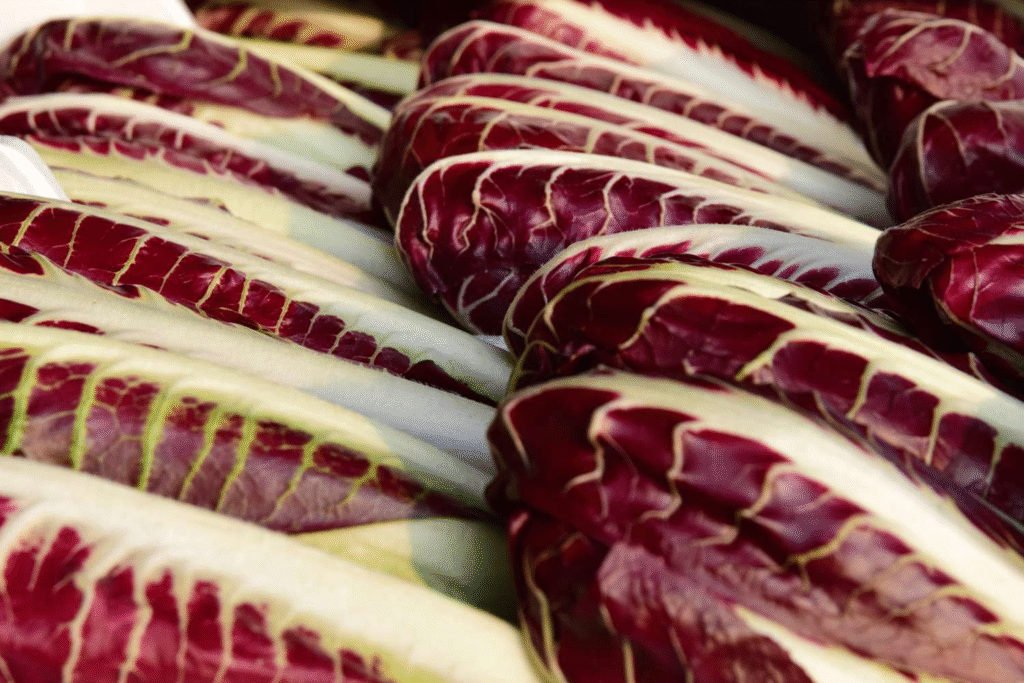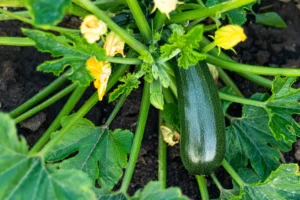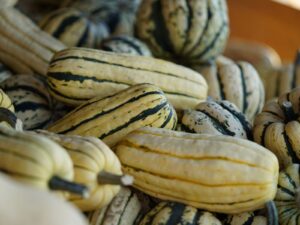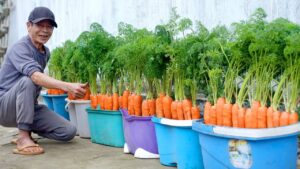How to Grow and Use Culinary Radicchio: A Complete Guide
Radicchio, with its vibrant purple-red leaves and distinctively bitter taste, has become increasingly popular in American kitchens. This Italian chicory adds a sophisticated touch to salads, pastas, and grilled dishes. If you’re looking to elevate your home garden with this gourmet vegetable, you’ve come to the right place. This comprehensive guide will walk you through everything you need to know about growing radicchio in your garden, in containers, or even indoors—regardless of your gardening experience level.
What Is Radicchio?
Radicchio (pronounced rah-DEE-kee-oh) is a leafy vegetable in the chicory family, prized for its colorful leaves and unique bitter flavor. While it resembles a small red cabbage, radicchio has a completely different flavor profile. Originally from Italy, radicchio has gained popularity in the United States as more Americans embrace Mediterranean cuisine.
There are several varieties of radicchio, each named after the Italian regions where they originated:
- Chioggia: The most common variety, forming round, cabbage-like heads with deep red leaves and white veins
- Treviso: Elongated in shape with pointed leaves, similar to romaine lettuce
- Verona: Resembles Chioggia but has a deeper, wine-red color
- Castelfranco: Has cream-colored leaves speckled with red or pink
- Tardivo: A specialty variety with distinctive finger-like leaves
Benefits of Growing Your Own Radicchio
Before diving into cultivation methods, let’s explore why growing your own radicchio is worthwhile:
- Freshness: Home-grown radicchio offers peak flavor and nutrition that store-bought versions can’t match
- Cost-effectiveness: A single packet of seeds can produce multiple harvests for a fraction of grocery store prices
- Variety access: Grow unique varieties rarely found in American supermarkets
- Reduced bitterness control: Proper growing techniques can help manage radicchio’s natural bitterness
- Year-round cultivation: With the right approach, you can enjoy fresh radicchio in multiple seasons
Growing Conditions for Radicchio
Radicchio thrives under specific conditions, and understanding these requirements is crucial for success:

Climate Requirements
Radicchio is a cool-weather crop that performs best in temperatures between 45-75°F (7-24°C). According to the USDA Agricultural Research Service, radicchio can tolerate light frost, which actually enhances its flavor by converting some of the starches to sugar, reducing the natural bitterness.
- Spring planting: Start seeds 2-4 weeks before the last frost date in your area
- Fall planting: Sow seeds in mid-summer for a fall harvest (often producing the best results)
- Winter growing: In USDA zones 8 and warmer, radicchio can grow throughout winter with some protection
Soil Conditions
Radicchio prefers:
- Well-draining, fertile soil with plenty of organic matter
- pH level between 6.0 and 6.8
- Consistent moisture without waterlogging
Growing Radicchio in Your Garden
Successfully growing radicchio in your garden requires careful planning and execution. Here’s a step-by-step guide:
Site Selection
Choose a location that:
- Receives partial shade, especially in warmer climates
- Has protection from harsh winds
- Offers good air circulation to prevent disease
Starting Radicchio from Seeds
- Direct sowing:
- Create shallow furrows about ¼ inch deep
- Space seeds 1 inch apart in rows 18 inches apart
- Cover lightly with soil and water gently
- Thin seedlings to 8-12 inches apart when they reach 2 inches tall
- Transplanting method:
- Start seeds indoors 4-6 weeks before transplanting
- Use seed-starting mix in cell trays or small pots
- Provide bottom heat (65-70°F) for germination
- Harden off seedlings before transplanting
- Transplant when seedlings have 3-4 true leaves
Care and Maintenance
| Task | Frequency | Details |
|---|---|---|
| Watering | 1-2 times per week | Provide 1-1.5 inches of water weekly; increase in hot weather |
| Fertilizing | Once at planting, again at midseason | Use balanced organic fertilizer (10-10-10) |
| Weeding | Weekly | Cultivate shallowly to avoid root damage |
| Mulching | Once after seedlings establish | Apply 2-3 inches of organic mulch |
| Pest monitoring | Twice weekly | Check for aphids, slugs, and cabbage loopers |
Common Problems and Solutions
Pests:
- Aphids: Spray with strong water jet or insecticidal soap
- Slugs: Set up beer traps or apply diatomaceous earth around plants
- Cabbage loopers: Hand-pick or use Bacillus thuringiensis (Bt) spray
Diseases:
- Powdery mildew: Improve air circulation and avoid overhead watering
- Bottom rot: Rotate crops and avoid planting in areas where lettuce family crops grew previously
- Downy mildew: Apply copper-based fungicide when conditions favor disease
Growing Radicchio in Containers
Don’t have garden space? No problem! Radicchio grows exceptionally well in containers.
Container Selection
Choose containers that:
- Are at least 8-10 inches deep and 12 inches in diameter
- Have adequate drainage holes
- Are made of food-safe materials
Potting Mix
Create an ideal growing medium by mixing:
- 60% high-quality potting soil
- 20% compost
- 10% perlite or vermiculite
- 10% coconut coir or peat moss
Container Planting Process
- Fill container to within 1 inch of the rim with potting mix
- Sow 3-4 seeds per container, ¼ inch deep
- Thin to the strongest seedling once plants reach 2 inches tall
- Place containers where they receive morning sun and afternoon shade
Special Container Care Considerations
- Watering: Check soil moisture daily, as containers dry out faster than garden soil
- Fertilizing: Apply liquid fish emulsion or seaweed fertilizer every 2-3 weeks
- Temperature management: Move containers to shadier locations during heat waves
Growing Radicchio Indoors
Yes, you can grow radicchio indoors year-round with the right setup!

Indoor Growing Requirements
For successful indoor cultivation, you’ll need:
- Light: A south-facing window or grow lights providing 10-12 hours of light daily
- Temperature: A cool room (60-70°F during day, slightly cooler at night)
- Humidity: 40-60% humidity (use a small humidifier if your home is very dry)
Indoor Growing Steps
- Choose shallow, wide containers with drainage holes
- Fill with high-quality potting mix enhanced with compost
- Sow seeds ¼ inch deep, 1 inch apart
- Mist the soil surface gently to avoid displacing seeds
- Cover with plastic wrap until germination occurs (5-10 days)
- Remove cover and place under grow lights or in a bright window
- Thin seedlings to 6-8 inches apart
Troubleshooting Indoor Growing Issues
- Leggy seedlings: Increase light intensity or move lights closer
- Leaf discoloration: Usually indicates nutrient deficiency; apply half-strength liquid fertilizer
- Slow growth: Check for adequate light, temperature, and nutrition
Harvesting and Storing Radicchio
When to Harvest
Radicchio is typically ready to harvest:
- 60-85 days after direct seeding
- 45-65 days after transplanting
- When heads feel firm to gentle pressure
Harvesting Methods
- Whole head: Cut the entire plant at soil level using a sharp knife
- Cut-and-come-again: Remove outer leaves while leaving the central growing point intact
- Forced radicchio: For advanced gardeners, dig up fall plants with roots intact and force in dark, cool conditions for sweeter heads
Storage Tips
- Store unwashed heads in the refrigerator crisper drawer in a perforated plastic bag
- Whole heads will keep for 2-3 weeks
- Cut leaves should be used within 2-3 days
- For longer storage, wrap heads in damp paper towels inside a plastic bag
Using Radicchio in the Kitchen
Now that you’ve successfully grown radicchio, it’s time to enjoy it in the kitchen!
Preparing Radicchio
To reduce bitterness:
- Soak leaves in cold water for 30 minutes before using
- Pair with sweet or fatty ingredients that balance the bitterness
- Grill or roast to caramelize natural sugars
Popular Radicchio Recipes
- Grilled radicchio: Brush quarter heads with olive oil and grill until charred and slightly wilted
- Radicchio pasta: Sauté chopped radicchio with bacon, garlic, and finish with cream
- Winter salad: Combine with sliced pears, walnuts, and blue cheese
- Radicchio risotto: Add chopped radicchio to risotto with Parmesan cheese
Nutritional Benefits
According to the USDA National Agricultural Library, radicchio is rich in:
- Vitamin K (important for bone health)
- Vitamin C (immune support)
- Antioxidants like anthocyanins (the compounds that give it the red color)
- Dietary fiber
- Low in calories (approximately 9 calories per cup)

Radicchio Market in the United States
While radicchio has been a staple in Italian cuisine for centuries, it’s relatively new to the American market. Here’s what you should know about radicchio’s place in US agriculture and cuisine:
Growth in Popularity
The US market for radicchio has grown significantly over the past decade, with:
- Increased presence in farmers’ markets
- Growing availability in conventional supermarkets
- Higher demand from farm-to-table restaurants
Commercial Production
According to the USDA Economic Research Service, California produces the majority of commercially grown radicchio in the US, followed by:
- Arizona
- Washington
- Oregon
- New Jersey
Market Value
Growing your own radicchio represents significant savings:
- Store-bought radicchio typically costs $3-5 per head
- A single seed packet ($2-4) can produce 20+ heads
- Specialty varieties can command premium prices of $6+ per head at farmers’ markets
Saving Seeds and Continuing the Cycle
For a truly sustainable radicchio growing experience, learn to save seeds:
- Select your best-performing plants to let flower
- Allow seed heads to form and begin to dry on the plant
- Harvest seed heads when they turn light brown
- Complete drying in a cool, dry location
- Separate seeds from chaff and store in paper envelopes
- Keep in a cool, dry place for up to 3 years
Conclusion
Growing radicchio at home—whether in your garden, containers, or indoors—allows you to enjoy this gourmet vegetable at its peak freshness while saving money and exploring varieties rarely found in stores. With proper planning and care, you can cultivate this nutritious and visually stunning crop throughout multiple seasons.
Remember that radicchio, like many worthwhile garden projects, may require some experimentation to perfect. Don’t be discouraged if your first attempt isn’t picture-perfect. Each growing season brings new knowledge and skills that will improve your results over time.
Now that you’re equipped with comprehensive knowledge on growing and using radicchio, it’s time to add this colorful Italian chicory to your gardening repertoire. Your salads, pasta dishes, and dinner guests will thank you!






